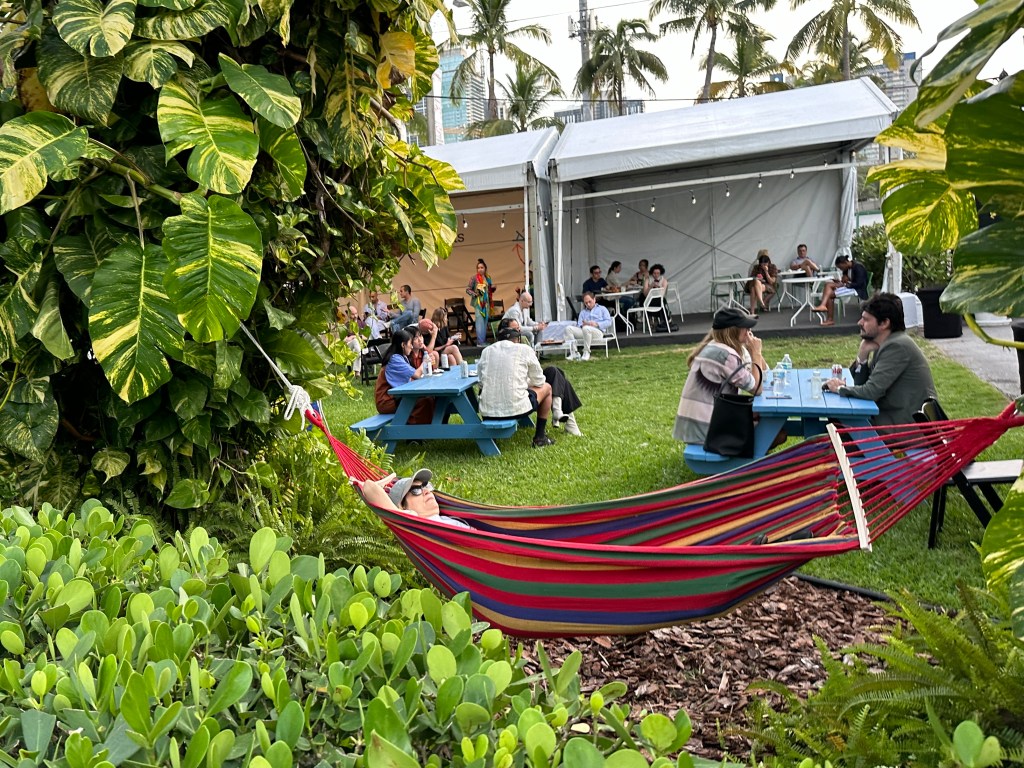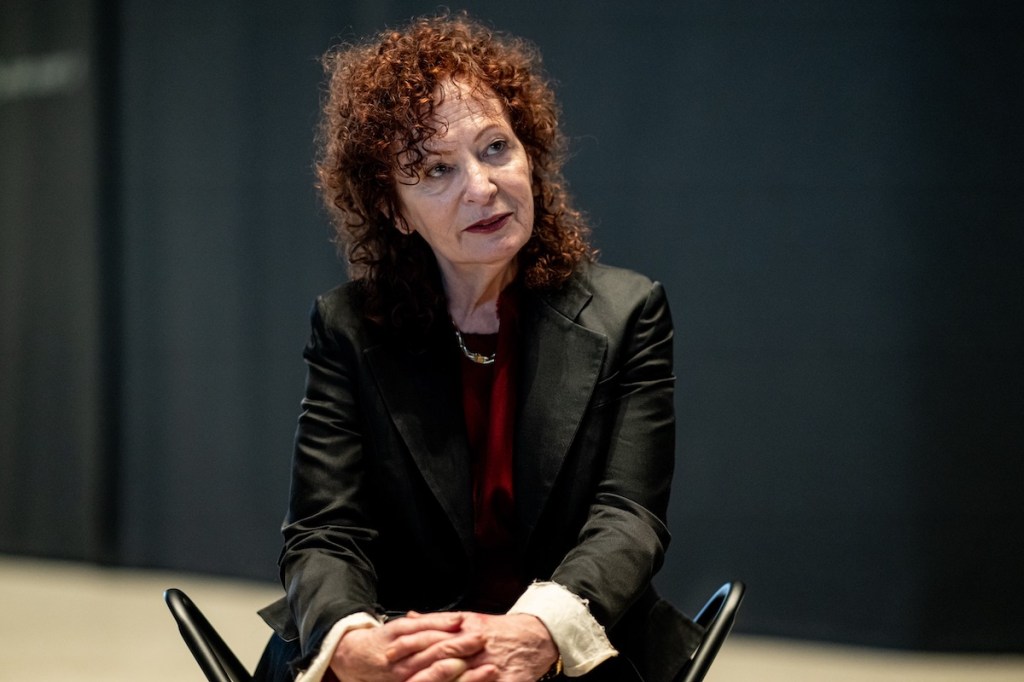During Miami Art Week, there needs to be a good reason to brave the traffic on the causeways over Biscayne Bay that connect Miami Beach and Miami proper. NADA Miami, one of the myriad art fairs that descend on the city in December, is worth a visit, for the booths as much as for the leafy, Gauguin-esque atmosphere outside the fair where visitors sip cocktails, take naps on colorful hammocks, or talk about said traffic.
The New Art Dealers Alliance, the non-profit that runs the fair, has gathered more than 150 galleries this year, with nearly three dozen first-timers. Like every art fair, NADA Miami could have used some editing, but making your way through the slightly confusing layout is a few hours well spent.
To point you in the right direction, we present the best booths of NADA Miami 2023.
-
Adrian Geller at Super Dakota
Image Credit: Courtesy Super Dakota At first glance, the Basel-born painter Adrian Geller’s picture of a man entering a garden, accompanied by a black sheep, feels like an extension of the tropical grounds that surround the art fair. But that’s where the similarities end. There is no air of casualness, no sense of relaxation despite the lush green border of Trampled Garden (2023). Dominating the center of the canvas is a brown mass of dirt littered with uprooted vegetables. The flattened perspective makes it seem like the man, who is so shocked at the destruction of his garden that his rake slips from his hand, could drown in the earth that he’d nurtured so for so long. It takes a few minutes to realize that in the top right corner, a sinister-looking group dressed in dark clothes are leaving the scene through a mangled section of the ornate fence that surrounded the once lush garden, all but blending into the wild, overgrown forest.
Earthy, organic works by Thom Trojanowski, LaRissa Rogers, and Tyler Macko flesh out the booth, serving as a breath of fresh air after a claustrophobic cab ride over the causeway.
-
Carrie Rudd at Polina Berlin

Image Credit: Courtesy Polina Berlin Gallery, New York. Photo: Steven Probert A joint showing of abstract works by artists Carrie Rudd and Tamo Jugel at first-time exhibitor Polina Berlin, an Upper East Side New York gallery established in 2022, begs for close inspection. Rudd’s work, in particular, feels at once like looking at an aerial view of a city and being lost among the stacks of a colorful library. In Double Frottage (But Not the Kind I Bet You Think I Mean) (2023), Rudd seems to ask the physical implements of painting what they are capable of achieving when they are applied to the canvas. How much motion does this color imply? How much depth can this shape take on? At the same time there are nods to her influences, Jasper Johns and Robert Ryman to name just a few, throughout the works. The result is a beautiful, complex mess that appears almost three dimensional.
“She’s obsessed with not repeating herself,” Berlin told ARTnews. “Every painting has to be a stand-alone idea, and she pulls from everywhere. A poem, an anecdote, a memory, anything can spark a new work and she often works on multiple paintings at once. The work is always deeply psychological.”
-
Ye Qin Zhu at Dimin

Image Credit: Courtesy, Dimin With three artists on view, the booth of downtown New York gallery Dimin is remarkably cohesive. The works are all tactile, from Erik Dalzen’s steel and expanded polyurethane foam sculptures to Jillian Mayer’s glass chandelier. Ye Qin Zhu’s mixed media panels stand out, however, for their archaeological nature. Through a mixture of found objects, religious iconography, and mass market toys and trinkets, Zhu’s assemblage Pure Without Being Precious (2023) shows the artist grappling with his identity as both immigrant and New Yorker. Bits of jewelry are covered, painted over and made to look disposable while bits of twig and leaf are emblazoned with gold. Despite the deep colors and glossy veneer the work feels organic, like a slab of petrified wood covered in a pictographic language that explains the culture of some long-forgotten society.
-
Tomas Harker at Sunday Painter

Image Credit: Silvia Ros There is something charming about Harker’s paintings of porcelain tea sets at London-based gallery Sunday Painter. A closer look, though, reveals the sadly comic nature of the works. A table is pristinely set for a meal, but the delicate porcelain dishes are adorned with a smiling portrait of Prince Charles and Lady Diana, a nod to the universal obsession with the past. The mugs, too, are decorated with the magical couple’s faces, enclosed in a heart. You can almost hear an older married couple discussing how much better things were “back then” over tea and dessert. There’s a murky out-of-focus quality to the paintings, but somehow they still appear bright, and sunny thanks to the brilliant white and bright blue.
Easily the funniest work is Novelty Tea Pot (2023) which features a small picture of a Margaret Thatcher that gives the iron-fisted prime minister an elephant nose. Its placement on the wall next to Diagnose the world (2023), a sickly green image of a pair of hands ripping a lobster apart, is worth the visit alone.
-
Georgina Treviño and Irgin Sena at Embajada

Image Credit: Courtesy Embajada It’s hard to point out one specific work at San Juan, Puerto Rico-based gallery Embajada. The booth itself seems to be one giant installation. A trio of works by Georgina Treviño, two handbags and a swing, grab your attention after passing through a curtain that hangs over the entrance of the booth. The handbags are vicious. One consists of a box grater off which hangs dozens of real knives. The other, titled Quítate el esmalte (2023), also metal, is decorated with carabiners and nail clippers with a strap and big, flashy rings stacked on one another, each with the size tag still attached, as if they were stolen from a smash-and-grab at a jewelry store. The swing, which hangs from the ceiling by thick metal chains, looks like a giant tattoo made out of shining metal. Behind the swing hangs a detailed drawing of a totaled car underneath a tarp by Irgin Sena. The drawing, unframed, hangs a few inches off the wall, its tattered edges towards the bottom casting soft shadows that contrast the hard metal of Treviño’s work.
-
Cristine Brache at Anonymous Gallery

Image Credit: @installshots.art The tragedy of 1970s playmate Dorothy Stratten, the actress and Playboy bunny who was murdered by her husband at the young age of 20, takes up the whole of Chinatown-based Anonymous Gallery’s booth. Out of focus and blurry, the paintings hint at the illusion of glamor and constant excess that surrounded the Playboy brand. Stratten and other Playboy bunnies are shown in multiple situations, being displayed on a stage in The Pageant (2023) and mugging for the camera in Les Demoiselles d’Avignon (Bunny Edition) (2023). Also on the wall are blurred paintings of roses that add to the drama. But the booth isn’t overly dour. America’s Sweetest Dream (2023) is a video installation featuring digitized, Super-8 films shot by Brache, overlayed with low-fi graphics inspired by 1990s late night TV ads for phone sex lines and commercials for Girls Gone Wild.
-
Jameson Green at Sorry We’re Closed

Image Credit: Courtesy Sorry We’re Closed Taking cues from Picasso, R. Crumb, and Philip Guston, Green’s painting of a Black musketeer, Musketeer Study (2023), practically jumps off the canvas. The work is as hilarious as it is disturbing, a middle ground Green is very comfortable sitting in.
“It’s all in his work, the personal, the political, history, he really draws from a lot of sources in such an interesting way,” art dealer Seb Janssen told ARTnews on Wednesday. Musketeer Study could be the most interesting homage to Picasso this year, which has seen no shortage of Picasso shows and commemorations fifty years after the Spanish master died.








